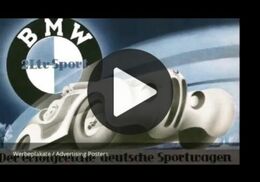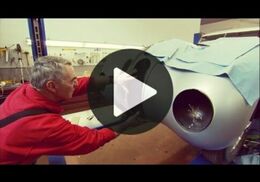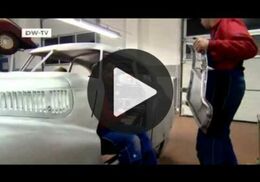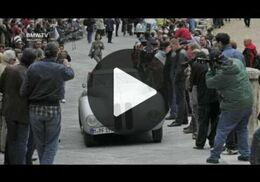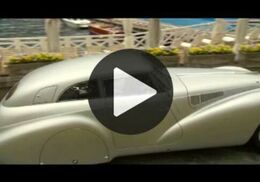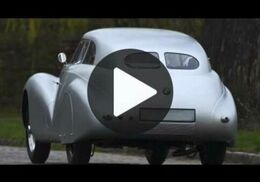BMW 328 Mille Miglia Kamm Coupé (diecast 1:43, autocult)
- BMW 328 Mille Miglia Kamm Coupé (from 1940)
- autocult
- 1:43
- Showcase model / No engine
- diecast
- Polaris Silver Metallic
- #04003
- online dealer (Peter Nasshan Modellautos)
- 89,90 EUR
- In near mint condition
- Original packaging exists
- Not for sale
Limited to 333 pieces
BMW 328 Kamm Coupé ( 1940 )
in my collection since 2016th
Information model:
An abrupt end
The Swiss Wunibald Irmin Erich crest was in the 1930s, Professor of Motor Engineering and Vehicle Engines at the Technische Hochschule in Stuttgart. In this capacity he founded the non-profit foundation Research Institute of Motor Transport Engineering and Vehicle Engines Stuttgart (FKFS), which allowed him a good cooperation with the automotive industry. Kamm's big advantage was that he had a wind tunnel, allowing him to explore on car-size their flow behavior. In the course of his experiments Wunibald Kamm came to a specially sophisticated form of rear-end design, which resulted in a minimized air turbulence, helping the car to an increased top speed.
Wunibald Crest modeled the tail shape with a sudden, almost steeply sloping end, pointing a teardrop shape. Although the optics used to looked under aerodynamic point was his stern version revolutionary and was soon under the name Comb tail its place in automotive history. Realized had Professor comb his idea of a BMW 328. With BMW, the managers of the individual piece of extraordinary performance promised because they optimized the chassis of the space frame to the extent that it was made of the lightweight material electron, making it only 30 kg the balance brought. Moreover, it was also the standard 6-cylinder engine, which normally had 90 hp, increased to a peak of impressive 136 hp and was 230 km / h fast. His grand entrance should celebrate together with four other 328ern at the legendary Mille Miglia in 1940 the car. The comb-BMW 328 was controlled by Conte Giovanni Lurani / Franco Cortese. However, the car could not prove its efficiency, because in the seventh round he fell because of technical defect prematurely.
That left the Kamm BMW of very large presence and success in the time last Mille Miglia denied. to provide more opportunities his athleticism prove not got the individual because of the Second World War forced to cease motorsports completely.
All BMW racing car bodies, who wrote in 1940 history at the Mille Miglia, excite people today wherever they appear. Only one of the silver BMW racing fleet missing up to now: The BMW 328 Kamm Coupé. It was named after the German aerodynamics pioneer Wunibald comb. The track of the car loses itself in 1953. Now BMW Classic has had to rebuild the cars and thus time for the 70th anniversary of the victory of BMW at the Mille Miglia is an important milestone not only in motorsport history but also in the history of vehicle aerodynamics back come to life. "We are very proud that we can present this vehicle to the public again," says Karl Baumer, Director of BMW Classic. "Those were great technical challenges, a lot of discussion and countless hours of research, but when you see the car for the first time, you feel, with what passion and connoisseurship all parties went to work -. Then and now"
When BMW made sure of uniqueness of the Mille Miglia cars soon after the victory in 1940 deliberately and we already managed it soon from Munich away to hiding in the country from destruction during the war to protect. This succeeded because every five vehicles survived almost intact. There were, however, the turmoil of the early post-war period, which meant that BMW lost the car. Some Allied soldiers were already in Germany in search of rare racecars. And so it was that the three Mille Miglia Roadster to Russia, Britain and America went. The winning Touring Coupé, initially in the hands of the Americans, was rescued by a senior BMW employee. He took it but at his emigration also with across the pond.
Only the Kamm Coupé remained in Germany. Ernst Loof, former BMW racing director, had secured it for themselves and used it as a private car. Meanwhile he himself become the automaker and supplied the emerging post-war Germany with the fast Veritas racing sports cars. Always in financial straits, he had to separate from the jewel after a few years. A long life under its new owner was the Kamm Coupé but not granted, because back in the early 50s it was scrapped after an accident.
About the historical value of this unique vehicle, there was no doubt as BMW mid-90s began to organize by establishing the "BMW Mobile Tradition" which focus on their own history on a wider scale. Plans for a replica of the comb-coupes were born quickly. But the recovery was difficult because there was no design documents about the stock of historic photos was low. Among the active support of a Munich private collector, however, managed to not only carry a larger inventory of photos together, showing the vehicle in different perspectives, also were again plenty of examples of the actual tube frame construction available.
Now it came to the difficult task of forming from the available information, the image of a complete vehicle. Some computer specialists in the design department took up the challenge. First, the striking photos were scanned to serve as a base in a 3D geometry program. Then the only safe constants such as rim diameter, offset, size of the headlights, door handles, wing nuts, Winker and BMW emblems were incorporated until they stood in each projection at the same place. Each image then gave further reference points for wheel arches, windows and other parts with respect to the fixed constants. Gradually the information until a virtual solid model revealed in every detail matched with each view of the vehicle compressed. From a milling program was generated, the milled by means of a 5-axis milling machine from a large high density foam block a full-scale model out.
A restorer was then commissioned to an original BMW chassis by 20 cm to extend and build a steel trellis frame to the photo templates. After a short time the project was, however, initially deferred.
As part of the concept for the new BMW Museum, the idea came up to make the intricate Elektron space frame of comb-coupe as a demonstration site for the "lightweight" again. With the help of specialists from the Munich region also managed to build an exact copy of the original space frame. The material they chose aluminum instead of the original electron and thus came by weight of the original very close. Although this exhibition frame was never intended to be completed sometime to a vehicle, the thought remained still alive.
A project of the Master School of Bodywork and vehicle Leipzig Leisnig-Erlbach in cooperation with the BMW plant in Leipzig then brought the ball rolling.
Originally it was planned to planking existing steel space frame with aluminum sheets to at least the appearance of the vehicle to be restored. At the master class is made imprints of foam model to it to form the body panels of the outer skin. The finished body model has since then served the BMW plant in Leipzig as an exhibit.
As part of the upcoming 70th anniversary of the Mille Miglia victory-one was determined at "BMW Classic" to implement the plan of reconstruction now. However, it took proven specialists to have actually arise from the available items a roadworthy vehicle. After the positive experience in the restoration of the BMW 328 Touring Coupé and Mille Miglia Roadsters for the New BMW Museum, had to fall here the choice on the restorer René Große from Wusterwitz in Brandenburg.
He took the foam model as the basis for an imprint in CSF, which was formed with wooden frames to form a stable, centrally divisible housing. In this half-shells into the pipes were fitted for the space frame with 25 mm diameter from a kaltaushärtbaren aluminum alloy. This had to be done with extreme precision, since no corrections were on the outer skin later have been possible. On the balance should show that you had the original value of 30 kg weight approximated here.
they used parts of a second set body panels made of pure aluminum, which had been made by the master school for the outer skin. Then there were all neuanzufertigenden sheets in the interior, such as internal fender, bulkhead, double the body floor, dashboard and fuel tank that had to be integrated into the existing form.
So called for the adaptation to the space frame all skill and experience of the coachbuilder from René Large Team. An interesting design detail were the 40 mm wide aluminum strips which were welded to the outer edges of the metal skin on the tube frame. To this, the outer skin was umgebörtelt to a few millimeters in width inward, so as to obtain visually delicate edges on the hood, the windows, doors and wheel housings. This detail, as well as the design of the hood hinge and the door hinges BMW could leave once patented, so it was for drawings from which one could reconstruct the parts as faithfully as possible.
Other challenges included technical changes that distinguished the Kamm Coupé by his brothers from the series, such as staggered back radiator, engine and transmission, a modified rear axle, as well as a number of other changes, which led to a consuming legwork by yourself.
In March 2010, it was finally time: the BMW 328 Kamm Coupe was handed over in a small ceremony at the "BMW Classic". Much time was no longer remained to prepare the newly purchased is racing car on his commitment: participation in the Mille Miglia 2010-70 years after the memorable event in 1940. (BMW 328 Kamm Racing Saloon (Replica 2010).
History In close cooperation with the streamlines pioneer
Professor Wunibald Kamm developed a BMW
Limousine build in streamlined form on the basis of
BMW sports car, 328. A space frame made of electrum
weighing only 30 kg was applied to the increased by 20 cm
Chassis mounted. That with an aluminum body
provided coupe was even lighter than the Roadster. Measured at reduced wind tunnel model Cw value of 0.25 was sensational, the top speed was 230 km / h.
On his first outing in the 1940 Mille Miglia
had the Italian drivers because of low
technical defect ad. When circuit races
Hockenheim 1947 Karl Kling was the only victory
the Kamm Coupé achieve.
built in 1940
Driver Conte Giovanni Lurani, Franco Cortese
Technical Engine 6-cylinder engine
data
Displacement 1,971 cc
Bore x stroke 66 x 96 mm
Power 136 hp at 6000 rev / min
Transmission Four-speed circuit
Brakes Alfin drum brakes ventilated,
Magnesium anchor plates
Weight 760 kg
Top speed 230 km / h
1369 Visitors since 08/19/2016
Comment
(0)
- Write a first comment about this model now!Any comment can be discussed by all members. It's like a chat.Mention other Modelly members by using @ in your message. They will then be informed automatically.
- Write a first comment about this model now!Any comment can be discussed by all members. It's like a chat.Mention other Modelly members by using @ in your message. They will then be informed automatically.



